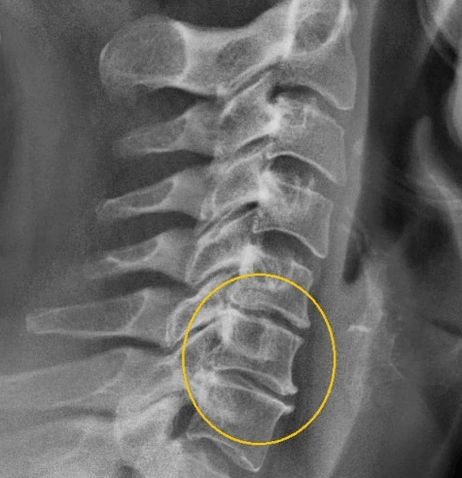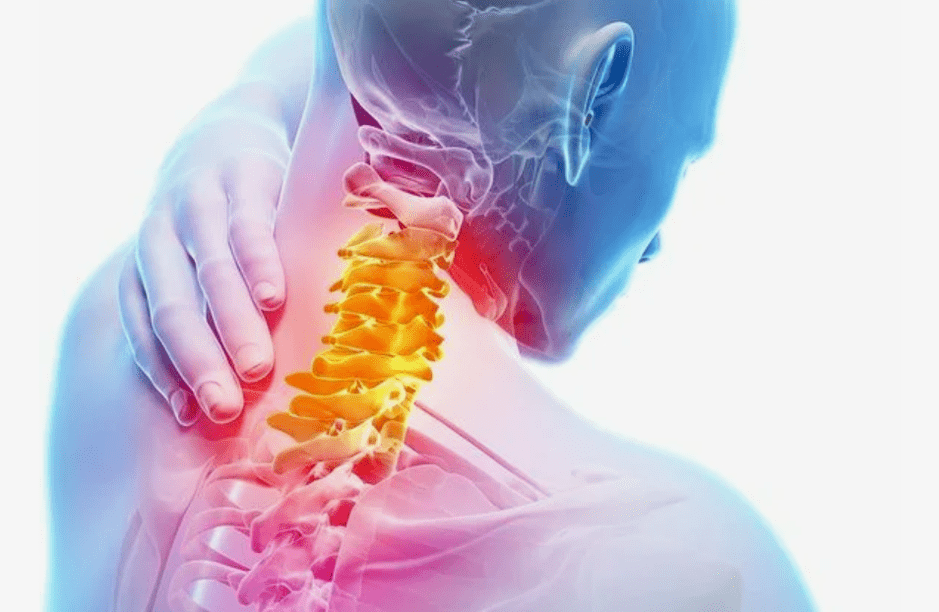Osteochondrosis is a common pathology of the spine, characterized by a distribution change in the structure of the cartilaginous discs of the vertebrae and their bone base. In one degree or another, osteochondrosis is manifested in most people after 30 years. The symptoms of cervical osteochondrosis are diverse, which often complicates diagnosis and subsequent treatment.

General symptoms and signs of cervical osteochondrosis
This process affects any of the column or several at the same time. Lumbar and cervical vertebrae are more affected by pathologies, such as the most susceptible to loads due to the anatomy of the human skeleton. The consequences of spinal osteochondrosis in the cervical region cause the most annoying and potential complications, because the neck is an area rich on neuromusive roads, many of which feed directly to the brain.
For this reason, clinical symptoms with cervical osteochondrosis are many associated with the ischemia of brain areas. In addition, nerve roots, which provide sensitivity and motor activity of the hands and shoulder waist, when squeezing with destroyed vertebrates, can give a variety of symptomatic images.
The signs of neck osteochondrosis depend on which of the body systems are affected by the pathology:
- The interrupted blood circulation due to the compression of the vertebral arteries determines most of the symptoms and signs of the brain.
- The compression of the roots left by vertebrates gives an image of peripheral nerve injury.
- The pinch of the spinal cord areas is associated with severe neurological pathologies found in advanced cases.
Next, consider the general clinic of osteochondrosis of the cervical column.
Pain on the back of the head, neck and neck area
This is the most common symptom. Pain location can be expanded, affecting the shoulders, clavicle, chest, moving to intense migraines of the head. The nature of pain depends on the location of the injury and the severity of the pathology. At first, pain can be quickly transitory, more and more chronic, sore. In moments of exacerbations, pain turned, with an increased tone of the neck muscles and a limited movement of the head.
Often, pain with cervical osteochondrosis can be located behind the sternum, in which case many patients take this symptom of angina pectoralis. Differentiation can be carried out by taking a nitroglycerin pill, pain due to osteochondrosis, are not eliminated.
Noise, buzzing, feeling of congestion in the ears
These symptoms often bind to a decrease in hearing. These phenomena are associated with a decrease in blood flow from vertebral arteries to vestibular. The complex of these symptoms is called cochlear or snail syndrome, and it is far from possible to determine its connection with osteochondrosis in the cervical region. A specific characteristic for differentiation is that they feel noise, congestion and sound in their ears when changing the position, after a long stay in a position.
Dizziness
The dizziness is also due to a violation of the blood flow to the organs of the inner ear, which guarantees the balance of the body. Nystagm often binds to dizziness: arbitrary fluctuations in the students of the eyes on the sides.
Shortness of breath
This sensation appears due to the irritation of the ends of the diaphragmatic nerve. It is a component of the cervical nerve beam and is involved in the regulation of breathing, its depth and frequency. Patients complain about the inability to breathe in the complete chest. In some cases, the symptom is aggravated to a severe lack of breathing and suffocation. For the same reason, breathing stops at night and snoring. The disadvantage of oxygen due to respiratory problems is ultimately the cause of fatigue, a decrease in concentration and memory problems.

Nausea
It is accompanied by Air Belling. Also due to problems with blood circulation in some areas of the brain and inner ear. Nausea is sometimes observed with indomitable vomiting, which is caused by head and body movements. The consequence of frequent nausea and vomiting is a decrease in appetite, weight loss, food failure.
Vision problems
"Full" in the eyes, a decrease in visual acuity, fog in front of the eyes: these are all symptoms due to the ischemia of the brain area that is responsible for the vision. Patients with osteochondrosis complain less frequently of the vision, since the lack of blood supply of the vertebral vessels is compensated by the blood flow of the carbon arteries system. The therapeutic glasses and gymnastics for the eye muscles do not solve the problem, in general, the vision improves after the treatment of osteochondrosis.
What are the most important symptoms of osteochondrosis is briefly referred to in this video:
Blood pressure board
An unstable pressure is due to the deteriorated blood flow in the oblong brain that is responsible for the functions of the vascular-motor center.
Sudden challenges or syncopal states
It occurs with spasm of the brain arteries due to the short -term arrest of the blood flow along the vertebral arteries. From the state of loss of the patient's consciousness, it can be quickly eliminated by placing it so that the legs are slightly higher than the head: the flow of blood to the brain allows a person to generate life. After a fainting attack, reversible problems with speech and movements can be observed, due to a brief stop of the blood flow, for some time.
Green symptoms
It can often be the only sign that indicates cervical osteochondrosis. They are expressed as perspiration, dryness and sensation of a lump in the throat, difficulties with swallowing. The symptoms are associated with the compression of the nervous plexus responsible for the innervation of the pharynx. It is necessary to differentiate such manifestations from a similar clinic for inflammation or neoplasms.
Raise body temperature
The increase in body temperature for cervical osteochondrosis is not the most typical symptom, it is rarely and locally observed: in the cervical and necklace area, with a slight redness of the skin.
The osteochondrosis clinic in the cervical column can be, first of all, varying degrees of gravity, it depends on the stage of development of the pathology, also during periods of exacerbations are brighter and, secondly, to form in certain syndromes.

Symptoms depending on the stage of cervical osteochondrosis
Stage i
The beginning of degenerative processes in the cartilage of the vertebral discs. The symptoms are weak, sometimes it cannot be observed at all. The first signs of osteochondrosis of the cervical column:
- Discomfort in the neck, arms, shoulders, sometimes become pain;
- headache;
- Easy restriction of the motor activity of the neck;
- Quickly passing visual disability;
- Reducing the sensitivity of the skin of the necklace area.
IMPORTANT: These symptoms become more pronounced by bowing their heads.
As a general rule, in the first stage of the osteochondrosis of the cervical region, patients do not go to the doctor, believing that all symptoms are associated with fatigue, stress, age, lack of sleep.
Stage II
At this stage, the protuberance of vertebrates, narrow intervertebral cracks, the fibrous ring fiber of the collagen disc fibrous is destroyed. There are notable painful symptoms of a punctual nature due to the compression of nerve trunks, which intensify during neck movements and head laps. Here you can suspect cervical osteochondrosis, whose symptoms in the second stage are the following:
- Pronounced pain in the neck, sometimes with a crunch;
- The skin of the shoulders and hands loses sensitivity almost completely;
- Headaches are frequent, do not pass for a long time;
- Visual disability with "flies" in the eyes;
- sound and noise in the ears;
- weakness of the muscles of the upper extremities;
- The clarity of tendon reflexes is reduced;
- shoot pain with dedication under the shoulder blade;
- the feeling of a lump in the throat, problems with swallowing;
- Sleep disorders, usually insomnia.
Long holding the head in a position leads to severe pain. At this stage of the development of the disease, patients already come to the doctor for help.
Stage III
The fibrous ring on the disc is destroyed, hernias are formed. In the third stage, there is a deformation of the spine, displacement and dislocations of the vertebrae due to its weak fixation. The symptoms are as follows:
- Intensive and sharp pain in the neck, neck area, heart area;
- The sensitivity of the scalp on the back of the head, in the shoulder region, in the hands, to the complete absence of;
- hernia of the cervical column;
- pairsis and paralysis of the upper extremities;
- Tendular reflexes are practically not observed.
This is a serious stage of the disease in which the patient can no longer keep his head on his own. The ischemia of the spinal cord and the compression of the arteries of the column cause a complete inability to move and reduce the forces in the muscles of other parts of the body, as well as the deteriorated spinal cord.

How to treat cervical osteochondrosis
The described state of the column is a very serious pathology that, negligence, leads to disability and as a result of deep disorders of brain circulation, and death. For this reason, by self -medication in case of such symptoms, it should not do so. Osteochondrosis is treated in a hospital and at home exclusively as a medical recipe. In the initial stages, the treatment of cervical osteochondrosis is conservative, including drug recipes: non -steroidal anti -inflammatory drugs, anesthetic, hormonal drugs, vitamin complexes, joint drugs, all this relieves inflammation, handling, improves the trophic of soft ones and the vertebra of the cartilage.
In the acute period, medications are prescribed in the form of injections, since the pain decreases, the patient goes to the tablets. Physiotherapy, massage, exercise exercises, usually prescribed in the remission stage, bind to drug courses. In difficult cases, osteochondrosis is treated with surgery.






























